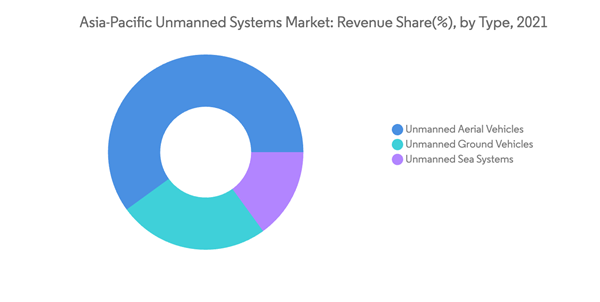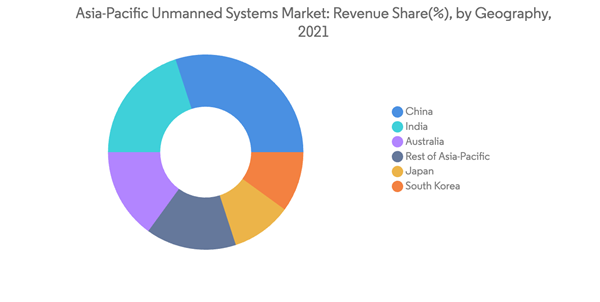The Asian-Pacific unmanned systems market is expected to register a CAGR of more than 8% during the forecast period (2022-2027).
The military sector of the unmanned systems market was unaffected due to the impact of the COVID-19 pandemic, as the investments into the development and deployment of unmanned systems remained unaffected. In the commercial sector, the number of applications in which unmanned systems are deployed increased even during the pandemic, driving the market demand.
The ongoing border issues and geopolitical tensions between the neighboring countries in the Asian-Pacific region have led to a rapid increase in military spending for the region. The increasing spending has led to investments in developing and introducing advanced unmanned systems fleet. This is expected to propel the market growth during the forecast period.
With the changing regulations for unmanned aerial vehicles in the countries, various companies are introducing and expanding their new drone services. This is expected to generate demand for the procurement of new UAVs in the future.
The growing emphasis on indigenous manufacturing in countries like China, India, and South Korea, among others, has led to an increasing share of local players with their significant investments in introducing new unmanned systems.
Similarly, China has been the global hub for drone industry manufacturing in the commercial sector over the past six years. China supports about 70% of the global civilian drone market. The growing application areas of drones are simultaneously propelling the demand for these UAVs in China. Furthermore, the maritime exploration, Shanghai University developed new USVs that can navigate autonomously to map the country's marine map. The USVs may navigate currents and avoid obstacles like icebergs, naval vessels, and reefs. Such robust growth in deploying unmanned systems in commercial and military sectors is expected to propel the market growth in the country during the forecast period.
On this note, in December 2021, Korean Air signed an agreement with the Korea Research Institute for Defense Technology Planning and Advancement (KRIT) for the research and develop technology for stealth UAVs. The agreement is expected to run through 2025, and Korean Air will work on the application of high-performance low-observable technology for next-generation UAVs. Such investments are anticipated to make the market more competitive in the future.
This product will be delivered within 2 business days.
The military sector of the unmanned systems market was unaffected due to the impact of the COVID-19 pandemic, as the investments into the development and deployment of unmanned systems remained unaffected. In the commercial sector, the number of applications in which unmanned systems are deployed increased even during the pandemic, driving the market demand.
The ongoing border issues and geopolitical tensions between the neighboring countries in the Asian-Pacific region have led to a rapid increase in military spending for the region. The increasing spending has led to investments in developing and introducing advanced unmanned systems fleet. This is expected to propel the market growth during the forecast period.
With the changing regulations for unmanned aerial vehicles in the countries, various companies are introducing and expanding their new drone services. This is expected to generate demand for the procurement of new UAVs in the future.
The growing emphasis on indigenous manufacturing in countries like China, India, and South Korea, among others, has led to an increasing share of local players with their significant investments in introducing new unmanned systems.
Key Market Trends
Unmanned Aerial Vehicles (UAVs) Segment held the Largest Share in 2021
The unmanned aerial vehicles (UAVs) segment accounted for the largest share of the market in 2021. This was primarily due to the growing investments of armed forces of the countries in Asian-Pacific regions towards the procurement of UAVs for intelligence, surveillance and reconnaissance missions, and combat applications. The countries manufacture new and advanced UAVs to cater to local requirements. India is currently working on the development of Ghatak, an autonomous stealthy unmanned combat drone that is being developed by the Indian Defence Research and Development Organisation for the Indian Air Force. The first flight was planned to be completed in 2021, and a full-scale prototype is expected in 2024-2025. Similarly, in January 2021, Japan’s Defense Ministry announced that a consortium of Japanese companies began manufacturing unmanned, remote-controlled fighter aircraft. The unmanned combat drones plan to introduce fighter drones in three stages and fully autonomous drones by 2035. The ministry plans to invest USD 24.3 million in the development of remote and flight control technology and another USD 1.84 million in AI technology for unmanned drones. Subaru, Mitsubishi Heavy Industries, and Mitsubishi Electric are currently working on the technology for unmanned fighters. Such planned investments into the development and introduction of UAVs are expected to boost the segment's growth.China Accounted for Largest Market Share in 2021
China currently dominates the market and is expected to continue its dominance over the market during the forecast period. This was due to the rapid investment of the country toward frontier technologies in unmanned warfare for land, air, and sea applications. The country introduced several advanced UAVs over the past decade with several new models for the armed forces. Some of the new UAVs introduced by the country in 2021 are the GJ-11 prototype, WZ-7, and WZ-8. Due to the ongoing tension with India, the People's Liberation Army (PLA) is expanding its UAV network in the Line of Actual Control (LAC) for intelligence, surveillance, and target acquisition and reconnaissance (ISTAR) capabilities and logistics support. Furthermore, in July 2021, the country developed a new UUV powered by artificial intelligence (AI) to identify and track submerged targets autonomously. Recently in January 2022, the PLA Army introduced a new Dragon & Horse II 8x8 UGV for ammunition carrying applications.Similarly, China has been the global hub for drone industry manufacturing in the commercial sector over the past six years. China supports about 70% of the global civilian drone market. The growing application areas of drones are simultaneously propelling the demand for these UAVs in China. Furthermore, the maritime exploration, Shanghai University developed new USVs that can navigate autonomously to map the country's marine map. The USVs may navigate currents and avoid obstacles like icebergs, naval vessels, and reefs. Such robust growth in deploying unmanned systems in commercial and military sectors is expected to propel the market growth in the country during the forecast period.
Competitive Landscape
The market of Asian-Pacific unmanned systems is fragmented due to several players providing unmanned systems for commercial and military applications. Some prominent players in the Asian-Pacific unmanned systems market are Israel Aerospace Industries Ltd, Elbit Systems Ltd, Singapore Technologies Engineering Ltd, Defence Research and Development Organisation (DRDO), and DJI. The international players are also gradually expanding their presence in the market due to partnerships and agreements due to their brand value. For instance, in June 2021, Huntington Ingalls Industries received the first international order from the Royal New Zealand Navy for four REMUS 300 unmanned underwater vehicles. The delivery of the UUVs was scheduled to begin by 2022. In addition to the presence of international players, domestic companies also have a significant share in the market. The domestic companies are partnering with the local governments to introduce new and advanced unmanned systems into service to support land, airborne and maritime missions.On this note, in December 2021, Korean Air signed an agreement with the Korea Research Institute for Defense Technology Planning and Advancement (KRIT) for the research and develop technology for stealth UAVs. The agreement is expected to run through 2025, and Korean Air will work on the application of high-performance low-observable technology for next-generation UAVs. Such investments are anticipated to make the market more competitive in the future.
Additional Benefits:
- The market estimate (ME) sheet in Excel format
- 3 months of analyst support
This product will be delivered within 2 business days.
Table of Contents
1 INTRODUCTION
4 MARKET DYNAMICS
5 MARKET SEGMENTATION (Market Size and Forecast by Value - USD million, 2018 - 2027)
6 COMPETITIVE LANDSCAPE
Companies Mentioned (Partial List)
A selection of companies mentioned in this report includes, but is not limited to:
- The Boeing Company
- Israel Aerospace Industries Ltd
- Elbit Systems Ltd
- AeroVironment Inc.
- DJI
- Defence Research and Development Organisation (DRDO)
- Hanwha Defense
- Milrem AS
- Singapore Technologies Engineering Ltd
- General Atomics
- Mitsubishi Heavy Industries Ltd
Methodology

LOADING...










